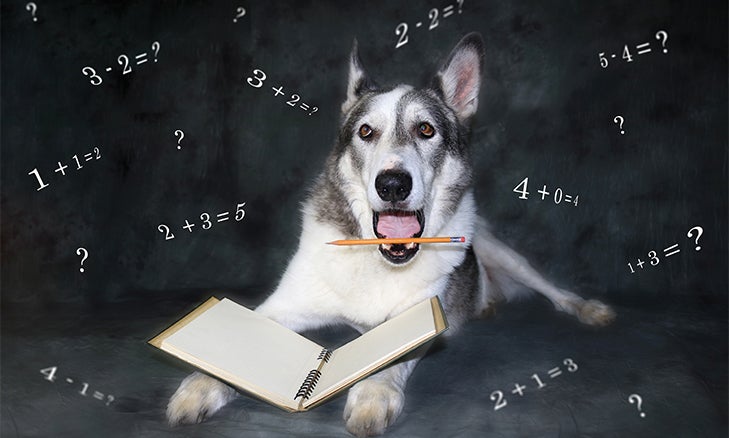
The idea that dogs might understand mathematics is apt to make many people laugh in disbelief. But when you consider that there are different forms of quantitative thinking, the theory is easier to consider.
Comparing Sizes
Early researchers tested dogs by putting out two balls of hamburger: one large and one small. They found that dogs were as likely to choose the small one as the large and concluded that dogs could not estimate size. But the test was flawed. Dogs think in an opportunistic manner — a mentality of “a bird in the hand is worth two in the bush.” If the two plates were at different distances, the dog would always grab the closest, but if they were at equal distances, the dogs showed that they understood the notion of size by going after the larger one.
Determining Quantity
A slightly more difficult aspect of quantitative reasoning is the judgment of numerosity. This simply refers to the ability to compare two groups of items. We do this when we judge which of two crowds contains more people. This can be done without counting or any idea of the specific number of people in either group. Thus a dog who runs to a pile containing 10 pieces of kibble rather than to the pile next to it that contains only two pieces of kibble makes that decision based upon his judgment of the number of kibbles in each pile. In the laboratory, dogs prove that they can judge numerosity by learning to press a panel that has more (or fewer) dots painted on it for a food reward.

Counting
The next level up is simple counting, an ability that dogs frequently demonstrate, especially those in the Working and Sporting Groups. For example, in field trials, retrievers must be able to count to know how many ducks are out in the field to retrieve.
Adding
If dogs can count, it seems natural to ask whether they can do simple arithmetic. Robert Young of the Pontifical Catholic University in Brazil, and Rebecca West of the University of Lincoln in the United Kingdom, attempted to confirm this idea by modifying a test that has been used to prove that human infants have the ability to count. The procedure involves something called “preferential viewing,” which measures the amount of time infants spend looking at things. Research confirms that infants (just like adults) will stare at something unexpected or unusual for a longer time.
The human test for counting is quite simple. The child is shown a small doll on a table, and then a low screen is put in front of it to block the child’s view. While the child watches, the experimenter takes another doll, shows it to the child and then puts it behind the screen. If the child can count, he should expect that when the screen is raised, he’ll see two dolls — and sometimes he does.
But sometimes the experimenter secretly removes one of the dolls, so that when the screen is raised, there is only one doll visible. When this occurs, the babies stare at what is on the table for much longer after the screen has been raised. This suggests that infants have made the mental calculation and are now surprised to find that the number of dolls they are seeing is different than what they expected.
In the canine version of this test, researchers showed the dog a single large treat, and then put a low screen in front of it. Then the dog watched as the experimenter placed another treat behind the screen. If the dog can do the math, he knows that one plus one equals two, so he should expect that when the screen was raised, there will be two dog treats. Just like in the case of the babies, sometimes the experimenters surreptitiously removed the second treat, so that when the screen was raised the dog saw only one.
As in the case of the babies, the dogs stared at this unexpected outcome for a longer time than they did when the arithmetic came out correctly, apparently “surprised” at what they saw. Similarly, if researchers secretly added an extra treat so that the dogs saw three instead of the expected two, the dogs appear to be equally surprised. This suggests that dogs cannot only count, but they can also do simple addition and subtraction.
The ability to count and do simple arithmetic might seem to be a superfluous skill for dogs, but it is a useful ability. For example, it is necessary for a female to know if all of her pups are present or if one of them had somehow gone astray and requires a search-and-rescue mission to be launched.
Despite this display of arithmetic ability in dogs, I wouldn’t give one my pocket calculator since he is still apt to view it as a chew toy rather than as a mathematical tool.
Originally published in AKC Family Dog

